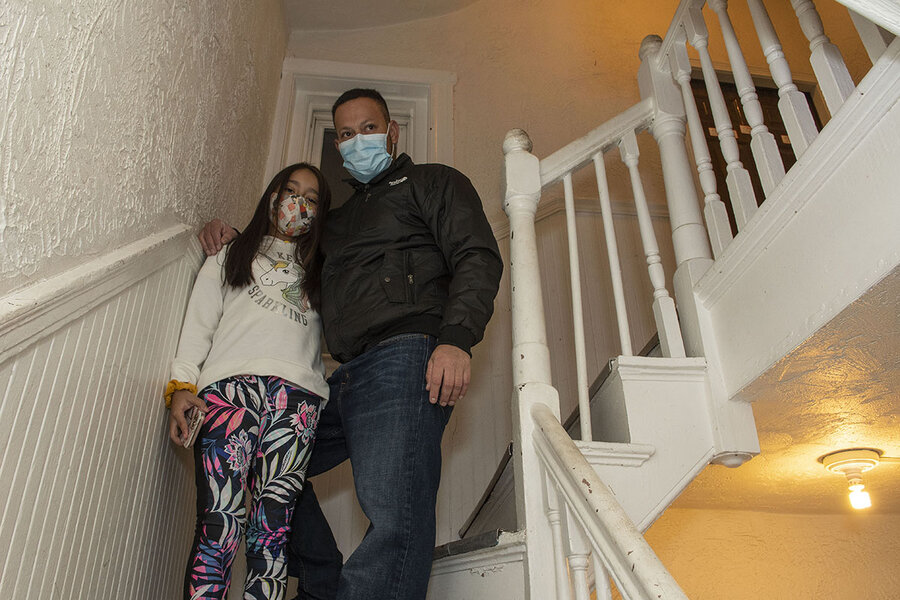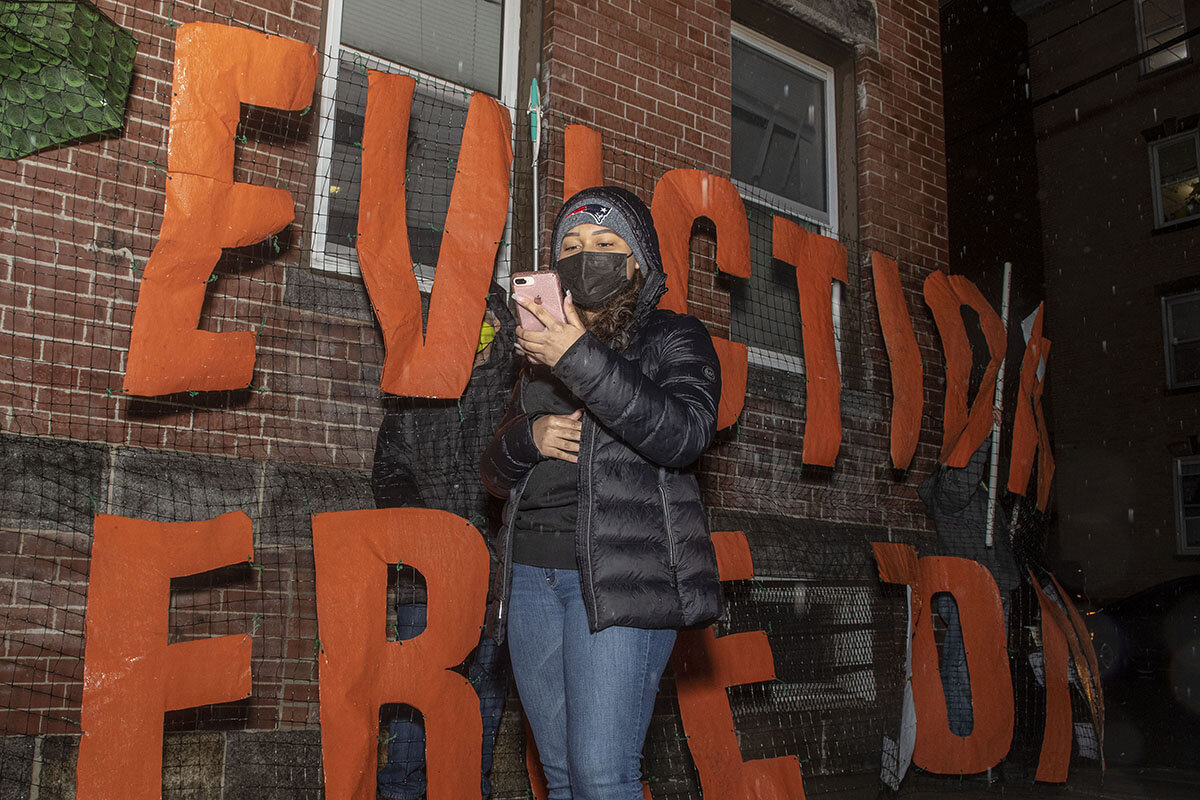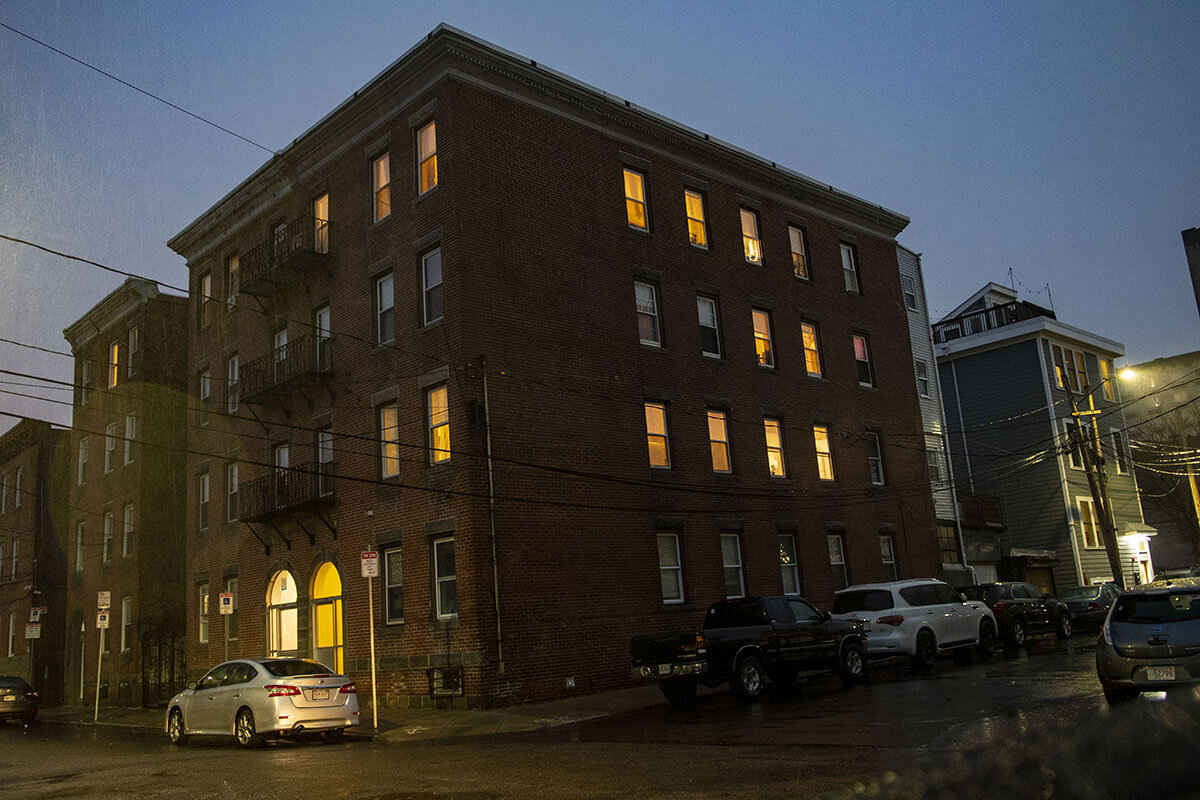‘Am I going to be evicted?’ Answer now may hinge on Congress.
Loading...
| Boston; and Springfield Township, Ohio
Jucosta Wilson of Walton, Kentucky, considers herself fortunate. Laid off in March, when pandemic-driven lockdowns caused unemployment to surge dramatically, she got rehired as a medical assistant at a dermatologist’s office three months later. But that gap in income, plus her husband’s loss of employment, caused the couple to miss some rent payments and their landlord wants them out.
“We’re being pushed into a situation that’s beyond our control. It’s not only hard to get out of that situation, but it’s even harder to survive in that situation,” says Ms. Wilson. The couple has a court date set for four days before Christmas.
In a gritty part of East Boston it’s only 5 p.m. and already dark, and raining. Nearly a dozen people brave the cold for a weekend rally at 168 Gove St., where the owner wants to evict his tenants – not because of nonpayment of rent but because he wants to develop condos.
Why We Wrote This
The pandemic has put “historic” pressure on renters in the United States. Here’s why it’s so important – to the economy, to health, and to people’s livelihood – to find a solution.
The group, organized by a social justice organization, chants slogans and listens to short speeches in Spanish and English next to a big banner that reads: “Eviction Free Zone.”
Despite a nationwide moratorium ordered by the Centers for Disease Control and Prevention and a few remaining state and local restrictions, evictions are ticking up across the United States. If Congress does not approve emergency rental and other assistance before the end of the year, today’s trickle of displaced tenants will become a flood that would be unprecedented for its size and speed. It is particularly worrisome during the pandemic, where evidence is mounting that the housing exodus is spreading the virus.
Families are doubling up at times when medical professionals want them to socially distance. Shelters, overwhelmed even in normal times, are already pushing out some of their existing clients because state and local mandates are forcing them to reduce capacity.
“The eviction crisis we are facing right now is historic,” says Diane Yentel, head of the National Low Income Housing Coalition, a social-policy organization in Washington. “If government doesn’t intervene, we’re looking at the very real possibility of tens of millions of people losing their homes this winter during this height of the coronavirus spread.”
Evictions actually spread the virus, according to a study released two weeks ago and not yet peer-reviewed. Researchers at UCLA and several other major universities found that states that lifted their moratoriums on evictions during the summer had 5.4 times more pandemic-related fatalities than states that kept their moratoriums in place for an extra 16 weeks.
“That amounted to 10,700 deaths due to eviction and COVID-19 that were entirely preventable,” says Emily Benfer, co-creator of the Eviction Lab at Princeton University and a law professor at Wake Forest University in Winston-Salem, North Carolina. For Congress “to turn their back on the health and well-being of adults and children across the country is unconscionable, especially at a time when their lives literally depend upon staying housed.”
No one knows how many evictions have taken place so far. The Eviction Lab, which tracks the forced removal of tenants in 27 U.S. cities, says landlords have filed 155,000 evictions since the pandemic. If the CDC moratorium is allowed to run out without some form of financial aid quickly, some 30 million to 40 million Americans could lose housing in a matter of weeks or months, according to an Aspen Institute study.
A key reason: The pandemic has meant reduced income for legions of Americans whose employment is tied to in-person services – from food and entertainment to retail shops and personal-care salons. Very often those workers are renters.
An emergency boost in unemployment benefits, coupled with the temporary eviction bans, helped stave off a crisis for renters in 2020.
But Congress has struggled to come up with a follow-on relief package after the roughly $2 trillion CARES Act was passed in March. As of Tuesday, Republican and Democratic negotiators seemed closer to agreement on a stimulus package of about $900 billion that could include provisions to delay a flood of evictions, such as $25 billion in rental assistance plus $300 a week in extra unemployment benefits for 16 weeks, to help struggling tenants.
For many renters, the future looks uncertain.
“I’m very scared about what’s going to happen. I mean, am I going to be evicted?” asks Shelby Brown, a single mother in Crittenden, Kentucky, who took a leave of absence in May to shepherd her children through the end of online school. Come summer, without any child care options, she quit her job as a pharmacy technician, which put her behind on rent, though a local anti-poverty nonprofit has since stepped in to help cover it.
“This has been our home for years now,” says Ms. Brown, who is still unemployed. “And I’m obviously trying to figure out what I’m going to do because I’ve applied for jobs but it doesn’t seem like anything that I’m doing is going to get me where I financially was.”
If current funding and protections expire, the number of evictions will go “completely through the roof” in January, says Kevin Finn, of Strategies to End Homelessness, a Cincinnati nonprofit. And due to social distancing precautions, homeless shelters are taking in fewer people. In Cincinnati and the surrounding county, the number of people sleeping outside has risen 35% between January and October, he adds. He attributes that to reduced shelter capacity, but also to family and friends being less available to host people who lose their housing, due to health concerns brought on by the pandemic.
The eviction crisis is also a landlord crisis. Stout Risius Ross, a global consulting firm, estimates that landlords will be owed somewhere between $13.2 billion and $24.4 billion in back rent by January. Much of the low-income housing in the United States is provided by mom and pop landlords who depend on rental payments for their own livelihoods.
“It is only a matter of time before both renters and housing providers reach the end of their resources,” said Doug Bibby, president of the National Multifamily Housing Council in a statement. The group, which represents landlords, found that three-quarters of renters had paid their December rent in the first week of the month, a nearly 8 percentage point decline from the same week a year ago.
Hardest hit are people of color. Last month, 30.6% of Black rental households and 17.5% of Hispanic households were behind in their rent, according to the Census Bureau. By contrast, 11.5% of white non-Hispanic rental households were in arrears.
A new home “is very hard to find,” says Melvin Acevedo, a tenant of the East Boston apartment complex that the landlord wants to turn into condos. A professional window washer, who has seen his work dwindle as owners of empty office buildings cut back on expenses, he and his family have managed to stay current with rent through careful saving. But finding a new place in gentrifying Boston? “It’s very expensive,” he says.
“The state has never seen this before,” says Lisa Owens, executive director of City Life/Vida Urbana, the local social justice group fighting the East Boston evictions. The ongoing evictions linked to gentrification, coupled with the surge of pandemic-related evictions for nonpayment, will create a wave that could overwhelm local and state government, she says. “We are not equipped to deal with this.”
One way the CARES Act has improved things for at-risk renters is that it has opened up more money for nonprofits to reach people, and work with them and their landlords, before they get evicted or become homeless.
“So our normal model where … people have to already be homeless before [government] can assist them, is actually the least cost-effective way to combat the issue of homelessness,” Mr. Finn says.
In Kentucky, Ms. Brown has been preparing for the worst, filling out reams of paperwork to apply for a rental-assistance program and going to food pantries. “You’re always hoping that things are going to get better and things are going to be where they need to be to work out. And sometimes I feel like they do for me,” she says. “But, you know, you still have to prepare.”
Editor’s note: As a public service, we have removed our paywall for all pandemic-related stories.








